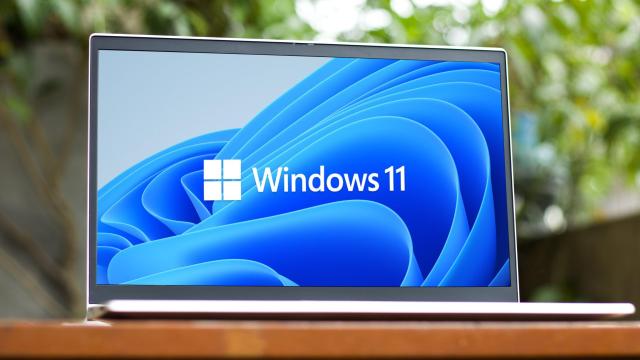While the nature of work is rapidly changing, at the end of the day, we still need to get things done — so it’s helpful when the technology we use for work thinks about that ahead of time, and includes ways for us to be more productive. Luckily, Windows 11 comes with built-in productivity tools that make it much easier to get that work done. Let’s take a look at the best features available.
Snap assist (snap layout and snap group)
Snap assist is a feature that makes it easy to snap together multiple windows on your desktop. Windows 11 improves upon this option with two new features, snap layout and snap group, which help you quickly arrange windows on your screen, making it easier to multitask or work across different applications.
Snap layout
With snap layout, you can hover over the maximise button of an app (or press Win+Z) to view different potential window positions. For example, you’ll see a dual split-screen option, which would snap the window to half the display, a four-way split screen, which would snap the window to one-quarter of the display, among other available options.
If you hover over one of the panels, you’ll see it turn blue, indicating Windows is ready to move your window to that position. Just click, and the window will snap into place, resizing it. You can use this feature to quickly reorganise your screen, and snap windows together into groups. Speaking of which:
Snap group
Snap group allows you to group together apps within your snap layout. Once you’ve created a layout, you can hover your mouse over the taskbar to see your newly created Snap group, which includes the apps you organised with your layout.
Minimising or restoring the group will also minimise or restore all the group’s apps without resetting your layout, allowing you to switch between multiple layouts as needed. It’s a great way to move grouped windows out of the way when you don’t need them, but bring them back quickly when you do.
If you want to tweak any settings for snap, you can find all available options in Settings > System > Multitasking.
Microsoft Teams integration in the taskbar
If you use Teams to keep in touch with co-workers, employees, or clients, Windows 11’s new integration (called “Chat”) will allow you to make calls and send messages directly from the taskbar, making the app feel a bit more like a built-in communication tool.
To use Teams to chat or start a video call, just access the app from its icon on the taskbar, or use Win+C. Here, you’ll see the most recent Teams activity. To initiate a video call, click Meet; to start a text conversation, click Chat. You can always open the full Teams app by clicking “Open Microsoft Teams” at the bottom of the window.
Focus Sessions
The Clock app in Windows 11 offers a surprising range of features for what appears to be a simple clock application.
Focus Sessions, for example, is a powerful productivity tool that allows you to block out sections of the day for productivity. You choose an amount of time to work, and the app will provide you with a timer that helps you keep track of the time you want to be productive.
If you choose to work for 45 minutes or more, the app will also automatically schedule a five-minute break during your schedule.
The app can connect with Spotify, which will let you play music while you work, including Spotify’s Deep Focus playlists. The Focus Sessions tool also connects with Microsoft To Do, allowing you to link tasks in your to-do lists to Focus Sessions. You can mark these tasks as complete directly from the Clock app.
The Focus Sessions tool even tracks your progress, keeping a record of how often you complete Focus Sessions and your current session streak.
Touch gestures
If you’re using Windows 11 on a computer with a touchscreen, like a Microsoft Surface laptop, you can take advantage of new touchscreen gestures.
These gestures allow you to use certain motions to perform tasks faster. In fact, they mirror Windows’ trackpad gestures. If you’re used to those gestures, you can replicate them right on the touchscreen. For example, you can scroll quickly by placing two fingers on the screen and sliding horizontally or vertically, or jump to the desktop by swiping down with three fingers. Here’s the full list:
-
Select an item: Tap the screen
-
Scroll: Place two fingers on the screen and slide horizontally or vertically
-
Zoom in or out: Place two fingers on the screen and pinch in or stretch out
-
Show more commands (like right-clicking): Press and hold the item
-
Show all open windows: Swipe with three fingers up on the screen
-
Show the desktop: Swipe with three fingers down on the screen
-
Switch to the last open app: Swipe with three fingers to the left or right on the screen
-
Open notification centre: Swipe with one finger in from the right edge of the screen
-
See widgets: Swipe with one finger in from the left edge of screen
-
Switch desktops: Swipe with four fingers to the left or right on the screen
Android App Integration
With Windows 11, you can download Android apps directly from the Microsoft Store via the Amazon Appstore. Once downloaded, you can run Android apps like any other application. If your workflow depends on Android apps, this feature can help you avoid having to rely on a phone or clunky Android emulation software.
If Amazon’s limited Android app market isn’t enough for you, you can always sideload your Android apps instead.
[MUO]

Leave a Reply
You must be logged in to post a comment.